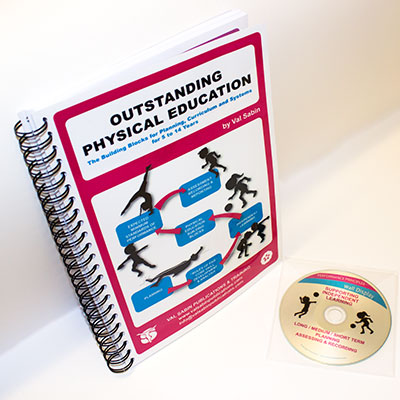Val Sabin Outstanding Physical Education:

Outstanding Physical Education manual provides teachers with the knowledge, understanding, guidance and specific content in physical education to challenge, progress, develop and inspire the children in their care.
It will mean their children will have the opportunity to achieve physical fluency of movement and physical literacy by having access to quality programmes in school, after school and possibly in the community.
The Building Blocks for Planning, Curriculum and Systems for 5 to 14 Years:
- Planning.
- “Rule of Five” core skill development & analysis.
- Independent learning.
- Physical education building blocks.
- Expected minimum standards of performance.
- Assessment recording and reporting.
Outstanding Physical Education Sample Pages
View Outstanding Physical Education Sample Pages
Outstanding Physical Education Training
Read about Outstanding Physical Education Training
Introduction to Outstanding Physical Education
How do we achieve and understand what Outstanding Physical Education is? The Outstanding Physical Education manual answers that question.
Using the methods and materials in this manual teachers can plan their curriculum and extra curricular programmes and work through systems that promote a unified approach to quality learning, progressions and inclusions.
There are detailed minimum expected standards of performance for all areas of curriculum PE that enable teachers to be aware of pupils’ prior and projected learning of skills and key processes. Performance Principles are included on a CD to form a wall display which promotes analysis, decision-making and independent learning by pupils.
Assessing, Recording and Reporting Systems, accurately helps to chart pupils’ progress and identify any targeted support required.
With the knowledge, material and systems understood and in place, teachers can then concentrate on the quality of their teaching and delivery.
So, working through the manual……….First of all we need to be aware of the National Curriculum and the programmes of study to be followed.
Long, Short and medium Term planning
Planning for a broad a balanced curriculum is essential. This manual identifies Long Term, Medium Term and Short Term planning with example sheets which provide a gradually more detailed overview of the planned curriculum.
Once that has been achieved, then core skills and principles are developed, together with key personal competencies and opportunities for application of knowledge. A model of analysis is gradually built up to enable teachers to take any core skill and elevate it from the most basic level through to its most advanced form.
These skills also logically progress from individual skill-learning and application through to pairs, small groups, larger groups and teams in different environments and contexts and can be seen in overview in the Building Blocks reference sheets.
Various teaching styles and strategies will engage children in the learning process, but perhaps one of the more under-used is pupil decision-making and independent learning. To encourage more independent learning (particularly in Dance and Gymnastics) a wall display has been included on the accompanying CD.
Knowledge of what children should be able to do, know and understand at different ages and stages of development is essential when planning a curriculum. Minimum Expected Standards of Performance are included.
They occupy a large proportion of the manual content, as they are identified in great detail for each of the six areas of learning – Athletics, Dance, Games, Gymnastics, Outdoor and Adventurous Activities and Swimming.
Clearly Defined Areas Of Activity
Standards are clearly defined for each area of activity at the ages of 7, 9, 11 and 14 Years. This not only enables teachers to create specific aims for their own year group, but also to see what standards they have or could have achieved in the previous two years.
This also works well for the Transition from Primary to Secondary Education as Secondary Schools can see what should have been achieved in Year 6 and use it as a baseline assessment. This will enable teachers to begin challenging pupils at an appropriate level from the start of their secondary education.
These Minimum Expected Standards will help in the performance of both teachers and pupils.
Finally, to give essential feedback to pupils, teachers and parents, focussed assessment, recording and reporting needs to be in place. This process should accurately record a pupil’s achievement and progress.
Some examples of recording sheets are offered together with an example of a childs’ self/peer assessment sheet and a teachers’ self/peer assessment sheet.
Price
£40.00 (Paperback)
Please contact us to place your order.

